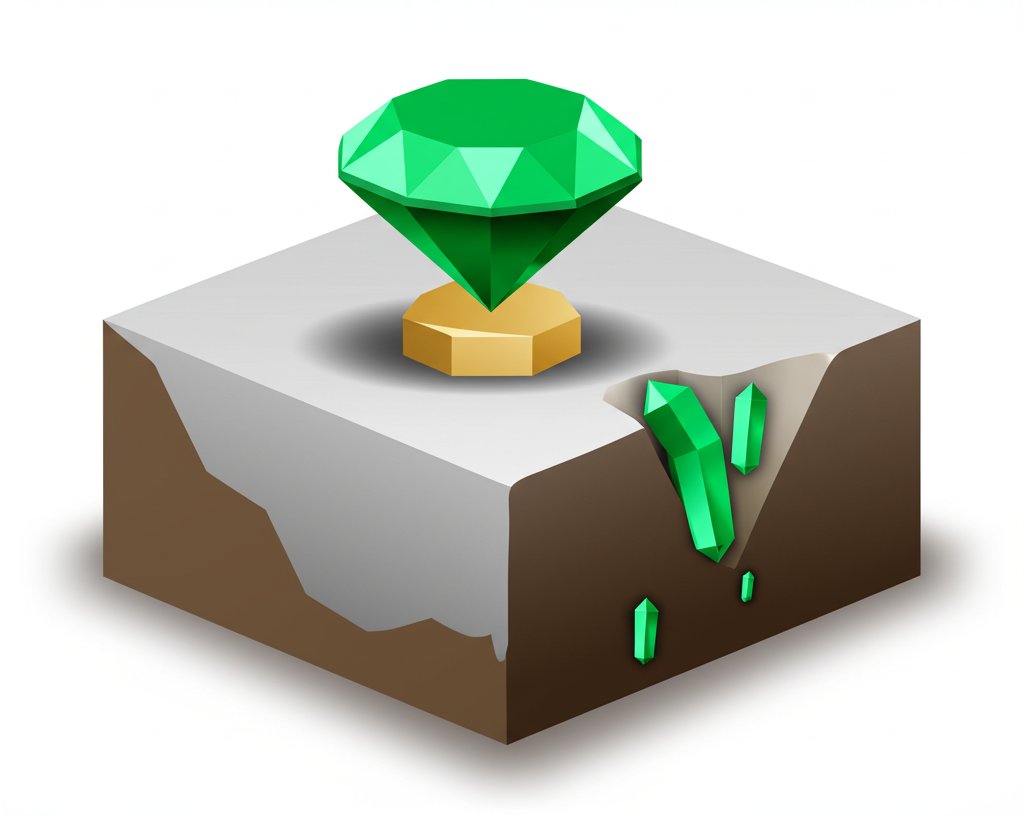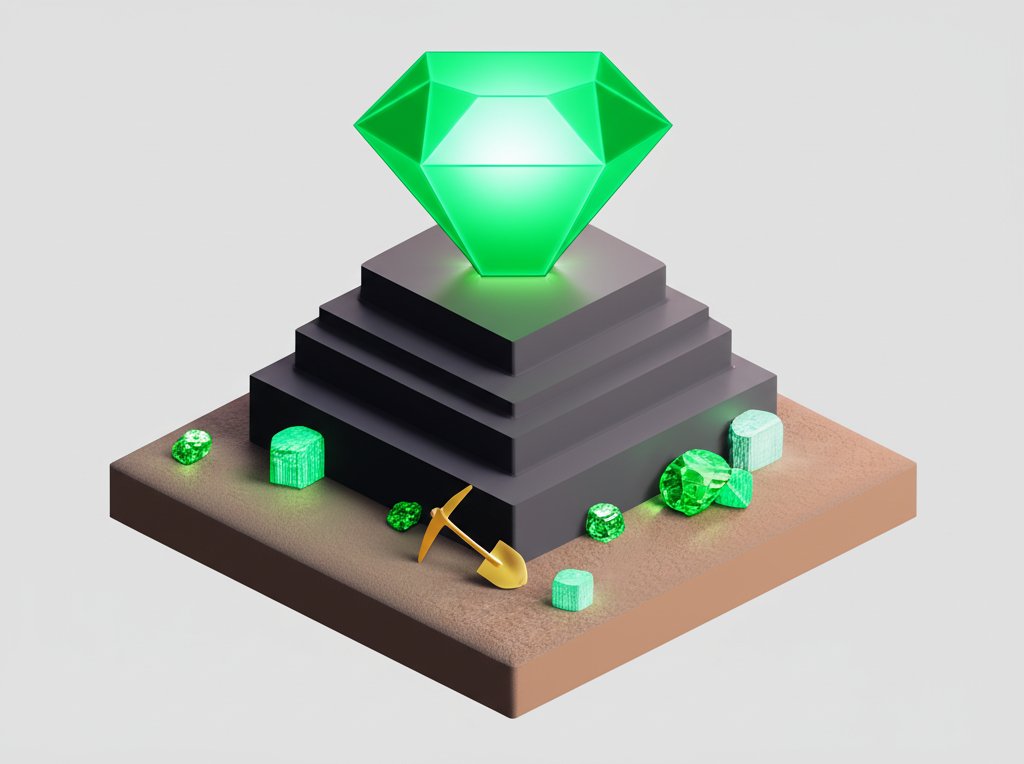From the deepest rainforests to the most ancient royal treasuries, one gemstone has consistently captivated humanity with its vibrant allure: the emerald. More than just a precious jewel, the emerald carries a profound gemstone symbolism that has resonated across cultures and centuries. Its lush green hue, reminiscent of life itself, evokes powerful feelings of renewal, growth, and eternity. If you’ve ever gazed into the captivating depths of an emerald and felt a sense of wonder, you’re tapping into a legacy of meaning. This article will delve into the extraordinary emerald symbolism, exploring the mystical history, cultural significance, and enduring spiritual power of these magnificent green gemstones, aiming to reveal the full spectrum of meaning behind the world’s most cherished green jewel.
The Luminous Lore of Emeralds: A Journey Through Time and Culture

The history of emeralds is as rich and multifaceted as the stone itself, interwoven with the rise and fall of empires, the beliefs of ancient civilizations, and the personal stories of those who cherished them. Understanding this historical context is key to truly grasping the symbolism behind emeralds.
Ancient Origins: From Cleopatra to the Conquistadors
The reverence for emeralds dates back thousands of years. The very name “emerald” is derived from the Greek word smaragdos, meaning “green stone,” a testament to its singular color.
- Ancient Egypt: Perhaps no figure is more synonymous with emeralds than Cleopatra, the last pharaoh of Egypt. She famously adorned herself with these green gemstones, not just for their beauty, but as powerful talismans of immortality, fertility, and rebirth, deeply connecting them to the goddess Isis and the eternal cycles of nature along the Nile. Egyptian mines, particularly those in Sikait and Zubara (Cleopatra’s Mines), were among the earliest known sources, operating as far back as 1500 BCE. Emeralds were frequently placed in burial artifacts, believed to grant eternal life and protect the deceased in the afterlife.
- Greek and Roman Empires: The ancient Greeks and Romans held emeralds in high esteem, associating them with the goddess Venus (Aphrodite), linking them to love, beauty, and regeneration. The philosopher Aristotle wrote about emeralds, prescribing them as cures for eye ailments and believing they enhanced memory, intelligence, and intuition. Roman natural historian Pliny the Elder famously declared, “nothing greens better.” They were carried as amulets and talismans for protection against evil and to bring good fortune.
- Inca and Muisca Civilizations: Across the Atlantic, the indigenous peoples of the Americas, particularly the Incas and the Muisca of Colombia, had their own profound connection to emeralds long before European arrival. The Muisca mined spectacular emeralds from their rich deposits, valuing them for their sacred qualities and incorporating them into ceremonial rituals, offerings, and intricate jewelry that signified spiritual power and connection to the earth. When the Spanish conquistadors arrived, the allure of these vibrant green gemstones fueled their conquests, leading to the global spread of Colombian emeralds.
- Indian Subcontinent: In Hindu culture, emeralds, with their vivid green, symbolized new life and were deeply connected to Lord Krishna, signifying nature and its sustenance. They were believed to bring good fortune, prosperity, and wisdom, making them favored by scholars and those seeking intellectual pursuits. The Mogul emperors of India were legendary collectors, inscribing their emeralds with sacred texts and wearing them as symbols of power and divine connection.
Cultural Reverence: Global Beliefs in Emerald Symbolism
The global spread of emeralds cemented their diverse yet universally positive gemstone symbolism. From protective qualities to their association with truth and eloquence, the stone became a conduit for various human aspirations:
- Wisdom and Prophecy: Many cultures believed emeralds granted the wearer foresight, enhancing intuition and offering glimpses into the future. They were thought to calm and clarify the mind, aiding in profound thought and problem-solving.
- Protection and Power: Across ancient civilizations, emeralds were considered potent protective talismans, capable of warding off evil spirits, negative energies, and even counteracting malevolent spells. Their vibrant green was seen as a symbol of immortality, ensuring longevity and vitality.
- Healing and Rejuvenation: The soothing green color was historically associated with healing, particularly for the eyes. Beyond physical ailments, they were believed to promote emotional balance, alleviate stress, and foster a sense of tranquility.
The Profound Meanings: Untangling Emerald Symbolism
The heart of an emerald’s allure lies in its intricate emerald symbolism. It speaks to many facets of the human experience, making it one of the most multifaceted and beloved green gemstones.
Love, Loyalty, and Lasting Relationships
Perhaps the most renowned symbolism behind emeralds is their deep connection to love, especially faithful and successful love. Often called the “Stone of Successful Love,” emeralds are believed to:
- Strengthen Bonds: They foster trust, mutual respect, and unwavering commitment between partners, making them a popular choice for engagement rings and anniversary gifts (especially for the 20th and 35th anniversaries).
- Promote Harmony: By encouraging compassion, forgiveness, and empathy, emeralds help resolve conflicts and cultivate a peaceful, loving environment in relationships.
- Heal the Heart: Associated with the heart chakra, emeralds are thought to open the heart to unconditional love, both for oneself and others, aiding emotional healing and deep connection.
Growth, Renewal, and Abundance
The verdant green of the emerald is inextricably linked to the natural world, symbolizing life’s continuous cycle of growth and renewal.
- Nature’s Embrace: Like the first shoots of spring, emeralds represent new beginnings, vitality, and the flourishing of life. They inspire optimism and a fresh perspective on challenges.
- Personal Development: These green gemstones encourage self-improvement, personal growth, and transformation. They serve as a reminder to embrace authenticity and strive for emotional and spiritual balance.
- Prosperity and Abundance: Historically, emeralds have been associated with wealth and good fortune. They are believed to attract prosperity and success, aligning one with the energies of abundance and fertile opportunities.
Wisdom, Intuition, and Foresight
Beyond emotional connections, emeralds are celebrated for their intellectual and spiritual properties.
- Mental Clarity: They are thought to stimulate the intellect, enhancing memory, focus, and mental acuity, thereby facilitating learning and deeper understanding.
- Intuitive Insight: Emeralds are believed to heighten intuition and psychic abilities, helping individuals gain clearer insight into situations and even provide a glimpse into future possibilities.
- Truth and Eloquence: Associated with honesty and clear communication, emeralds are said to encourage truthfulness and enhance eloquence, allowing for authentic self-expression.
Protection, Healing, and Emotional Balance
The protective and healing qualities of emeralds have been revered for millennia, offering a sense of security and well-being.
- Guardian Stone: As a powerful protective talisman, an emerald is believed to shield its wearer from negative energies, ward off evil spirits, and protect against enchantment.
- Restorative Powers: Historically used for physical healing, particularly for eyesight, emeralds are also sought for their ability to restore vitality and energy.
- Calming Influence: On an emotional level, the tranquil green hue is thought to bring a calming effect to the mind, alleviating stress, promoting inner peace, and fostering overall emotional stability.
Royalty, Power, and Prestige
Throughout history, emeralds have been the gemstone of choice for kings, queens, and emperors, firmly establishing their gemstone symbolism as one of power and supreme status.
- Status Symbol: Their rarity and dazzling beauty made them exclusive to the elite, signifying wealth, influence, and unchallengeable authority.
- Imperial Adornment: From Cleopatra’s jewelry to the crowns of European monarchs and the bejeweled artifacts of the Mughal Empire, emeralds have consistently been at the pinnacle of royal adornment, symbolizing divine favor and sovereign might.
- Immortality: The enduring green of the emerald was often associated with eternity and immortality, a fitting symbol for rulers who sought to cement their legacy.
Emeralds Among Green Gemstones: A Unique Hue
While many beautiful green gemstones exist, emeralds hold a distinct status, often considered the quintessential green gem. What sets them apart in the vast world of minerals?
What Makes Emeralds Stand Apart?
Emeralds are a variety of the mineral beryl, colored by trace amounts of chromium and/or vanadium, which give them their signature vivid green to bluish-green hue. It’s not just any green; it’s a specific, rich, and often deep green that is unparalleled.
To learn more about the characteristics that make this gemstone so special, and other gems like it, you can explore interesting gemstone facts and lore on our website.
- The “Emerald Green”: The color is paramount. A true emerald must possess a distinct, saturated green. Lighter beryl varieties, even if green, are simply known as green beryl, not emeralds. This specific “emerald green” is highly prized and instantly recognizable.
- Natural Inclusions (Jardin): Almost all natural emeralds contain characteristic inclusions, often described as a “jardin” (French for garden), which adds to their unique charm and authenticity. Unlike diamonds where inclusions detract from value, a beautiful jardin can be part of an emerald’s appeal, provided it doesn’t compromise durability or transparency.
- Rarity and Value: High-quality emeralds, with excellent color and clarity, are rarer and often more valuable than diamonds of comparable size. The combination of their specific chemical composition, geological formation, and intense color makes them exceptionally precious.
Other Notable Green Gemstones
While emeralds reign supreme in symbolic significance, it’s worth acknowledging other beautiful green gemstones, each with its own characteristics and charm:
- Peridot: A vibrant lime-green gemstone, often associated with spiritual purification and prosperity. It’s a much softer stone than emerald.
- Jade (Jadeite & Nephrite): Revered in Asian cultures for centuries, jade symbolizes purity, serenity, and harmony. Its colors range from pale to deep green.
- Green Tourmaline: Offering a wide spectrum of greens, from light mint to deep forest, green tourmaline is known for promoting compassion and creative expression.
- Tsavorite Garnet: A brilliant, vivid green garnet, known for its exceptional sparkle and often compared to emerald, though typically more durable and without the characteristic inclusions.
- Chrome Diopside: An intense, deeply saturated green gem, often appearing almost black in larger sizes, known for its striking color and more affordable price point compared to emeralds.
- Malachite: An opaque, banded green stone, symbolizing protection, healing, and transformation.
While these gems offer stunning green alternatives, none quite capture the historical depth, widespread cultural reverence, and specific emerald symbolism that places emeralds in a category of their own.
Practical Aspects: Caring for Your Symbolic Emeralds
To preserve the profound emerald symbolism and captivating beauty of your treasured green gemstones, proper care is essential. Emeralds, while beautiful, require a more delicate touch than some other hard gemstones.
Understanding Emerald Characteristics
- Mohs Hardness: Emeralds rank 7.5 to 8 on the Mohs scale of mineral hardness. This means they are durable enough for daily wear but are more prone to chipping or scratching than diamonds (10) or sapphires (9).
- Inclusions (Jardin): As mentioned, the “jardin” is natural. However, these natural fractures can make emeralds more susceptible to impact damage. Many emeralds are also treated with oils or resins to fill surface-reaching fractures and enhance their appearance, which necessitates special care.
Cleaning and Maintenance Tips
- Gentle Cleaning: The best way to clean emeralds is with warm water, a mild soap (like dish soap), and a very soft brush or cloth. Gently wipe or brush the stone and rinse thoroughly with clean water.
- Avoid Harsh Chemicals: Steer clear of harsh detergents, abrasive cleaners, and household chemicals, as these can strip the oils or resins used in treatment, affecting the stone’s appearance and potentially damaging its surface.
- No Ultrasonic Cleaners or Steam Cleaners: Ultrasonic cleaners use vibrations that can exacerbate fractures in emeralds, and steam cleaners use high heat, both of which can cause damage or remove fracture fillers.
- Protect from Impact: Remove emerald jewelry during activities that might expose it to blows or rough contact. Store emeralds separately from harder gemstones to prevent scratching.
- Professional Check-ups: Have your emerald jewelry professionally inspected and cleaned periodically by a reputable jeweler who understands emeralds. They can re-oil or re-treat the stone if necessary.
Identifying Authentic Emeralds
Given their value, understanding what constitutes a genuine emerald is crucial.
- Color is King: A true emerald exhibits a distinct, vibrant green or bluish-green color. It should not be too light or yellowish/brownish to be considered an emerald.
- Clarity and Inclusions: While inclusions are common, their extent and impact on transparency are important. Too many visible inclusions can diminish value and durability.
- Cut: The cut of an emerald (often the “emerald cut” itself, a rectangular or square step cut) is designed to enhance its color and minimize stress on the stone.
- Origin: Reputable sources will often specify the origin (e.g., Colombian, Zambian, Brazilian), which can influence characteristics and value. However, origin alone doesn’t guarantee quality.
- Certification: For significant emerald purchases, always seek a certification from a respected independent gemological laboratory (e.g., GIA, Gubelin, SSEF). This document will detail the stone’s characteristics, treatments, and authenticity.
Modern Interpretations & Wearer Connection
The ancient emerald symbolism continues to resonate in contemporary times, adapting to modern lifestyles while retaining its profound essence.
Emeralds as a May Birthstone
For those born in May, the emerald is their official birthstone, imbuing the stone with personal significance and a special connection. Wearing an emerald is believed to bring good fortune, health, and a youthful spirit to May-born individuals. It aligns with the season of spring, further emphasizing themes of growth, renewal, and new beginnings for its wearers.
Incorporating Emerald Energy into Daily Life
Beyond jewelry, the powerful energies of these green gemstones can be harnessed in various ways:
- Meditation: Meditating with an emerald can help open the heart chakra, promote emotional healing, and enhance intuition and spiritual clarity.
- Home Decor: Placing emeralds or objects with emerald green aesthetics in your living space can invite energies of prosperity, growth, and tranquility, creating a harmonious environment.
- Personal Amulet: Carrying a small tumbled emerald can serve as a personal talisman for protection, luck, and emotional balance throughout your day.
Emeralds in Jewelry Design
From classic solitaire rings to intricate vintage pieces, emeralds continue to be a favored choice for jewelry designers and wearers alike. Their vibrant color makes them a striking centerpiece, often paired with diamonds or other complementary gemstones. Modern designs often celebrate the emerald’s natural beauty, sometimes even incorporating the unique jardin as a testament to its authenticity. The enduring popularity of emeralds in engagement rings speaks to their unwavering symbolism behind emeralds as a promise of enduring love and a vibrant future.
Conclusion: The Enduring Legacy of Emerald Symbolism

The captivating allure of emeralds goes far beyond their undeniable beauty. As one of the most revered green gemstones, they carry a weight of history and a legacy of meaning that spans millennia and cultures. From ancient Egyptian pharaohs to modern-day lovers, the symbolism behind emeralds has touched countless lives, embodying notions of love, loyalty, growth, wisdom, protection, and prosperity.
Choosing an emerald is more than just selecting a beautiful gem; it’s embracing a profound connection to the earth’s natural energies and a rich tapestry of human history and belief. Whether cherished as a personal talisman, a symbol of enduring affection, or simply admired for its breathtaking green luster, the emerald remains a timeless reminder of life’s vibrant cycles and the deep, often hidden, meanings that surround us. Unlock the profound green gemstone symbolism of the emerald and let its ancient wisdom and vibrant energy enrich your life.
FAQ
What is the primary symbolism of emeralds?
Emeralds primarily symbolize love, loyalty, growth, renewal, wisdom, and protection. They are often called the “Stone of Successful Love” and are associated with prosperity and new beginnings.
Which cultures valued emeralds and why?
Many ancient cultures revered emeralds. The Egyptians linked them to fertility and immortality (Cleopatra, Isis). The Greeks and Romans associated them with love, beauty, and healing. The Incas and Muisca held them sacred for spiritual power and ceremonial use. In Hindu culture, they symbolized new life, wisdom, and good fortune, connected to Lord Krishna.
How do emeralds relate to love and relationships?
Emeralds are strongly associated with love, fidelity, and lasting relationships. They are believed to foster trust, strengthen commitment, promote harmony, and encourage compassion between partners. This makes them a popular choice for romantic gifts and engagement rings.
Are emeralds considered healing stones?
Yes, historically, emeralds have been regarded as healing stones. Ancient civilizations believed they could heal eye ailments and promote overall physical well-being. On an emotional level, they are thought to bring inner peace, alleviate stress, and foster emotional balance and healing by opening the heart chakra.
What is the difference between an emerald and other green gemstones?
While many gemstones are green, an emerald is specifically a variety of the mineral beryl, colored by trace amounts of chromium and/or vanadium, giving it a distinct, rich green to bluish-green hue. Other green gemstones like peridot, jade, and green tourmaline are different mineral compositions and often have different shades of green, hardness, and internal characteristics. Emeralds are uniquely defined by their specific color saturation and often by characteristic natural inclusions known as “jardin.”
How should I care for my emerald jewelry?
Emeralds require gentle care. Clean them with warm water and mild soap using a soft brush or cloth, then rinse thoroughly. Avoid harsh chemicals, abrasive materials, ultrasonic cleaners, and steam cleaners, as these can damage the stone or its treatments. Always store emeralds separately to prevent scratching, and remove them during strenuous activities.
Is emerald a birthstone?
Yes, the emerald is the traditional birthstone for May. It is believed to bring good fortune, health, and a youthful spirit to those born in this spring month, aligning with the stone’s symbolism of growth and renewal.










